目次をご覧になりたい方はクリックしてください→
- 1 Turn
- 1.0.1 • Entry
- 1.0.2 • Preparation of turn
- 1.0.3 • Reduce the load. Extension. Release the twist. → The board turns.
- 1.0.4 • Switch of the edge
- 1.0.5 • the latter part of turn
- 1.0.6 “Head (face) and the upper body (breast) face to the bottom“
- 1.0.7 “Always face to the bottom” ↓ Consequently “you unintentionally face outside of turn at times”
- 1.1 • Attitude of traverse at entry
- 1.2 • Case of a turn followed by the next turn
- 1.3 To turn continuously.
- 2 Attitude, CG (Center of gravity)
Monoski~See top page and Contents here
Turn
Now, here we are.
The essence of Monoski : Turn.
If you could have done this, you could have done “Monoski”.
• Entry
First, enter traversing practiced above.

1. traverse
“Hips and knees to the bottom.
Head and the upper body to the top.”
Watch the edge lies down (flatten)!
• Preparation of turn

2. Compress. Shift the CG. Twist.
- Compress the whole body, and sink down.
- Shift the CG. Incline the head and the upper body to the bottom.
- Twist the upper body to the direction you want to turn i.e. inside the turn. In brief, face to the “bottom” and consequently you’ll get this attitude.
I wrote 1.2.3 but do all the same time, not in this order.
Hips and knees are bending so very much.
Bend about breast touches knees.
You need to do like this to turn Monoski.
Watch the edge already inclines to the bottom, and becomes parallel to the snow (slope)!
• Reduce the load. Extension. Release the twist. → The board turns.

3. Reduce the load. Extend about to jump.
Extend about to jump.
If the board becomes parallel to the snow surface and doesn’t bite the snow, twist will be released and the board will turn itself very easily.
• Switch of the edge

4. Switch of the edge
After reduced the load and turned the board, the edge has switched to the inside of turn.
You can see bottom surface of the board.
It’s in-edge of outside-foot about two-legged normal ski, but out-edge of inside-foot about Monoski.
Complicated, don’t you?
• the latter part of turn

5. the latter part of turn. Head and the upper body face to the “bottom”.
Different from two-legged normal ski, knees incline to the outside of turn, and the board is flattened so that the edge won’t bite the snow.
Of course, if you would run faster, the board would become to stand up and the edge take effect.
Don’t worry about it, you will naturally become like “so” without consciousness. =^^=
It’s important that already
“Head (face) and the upper body (breast) face to the bottom“
prepared to the next turn.
In many textbooks or videos of ski, we see the word “face outside of turn”.
But, it misleads us.
Ojisan (it’s me!) also have troubled by this word to practice ski (^_^;)
Forget it!
You must not face outside of turn.
“Always face to the bottom”
↓
Consequently “you unintentionally face outside of turn at times”
Never look outside of turn.
Always look the bottom.
Teachers and trainers often use difficult, complicated, or misleading “jargons”.
They misunderstand that trainees respect them who use “jargons”.
In addition, they misunderstand they’ve become quite a good teacher or trainer to use “jargons”.
Ojisan intend to use simple words and write sentences easy to understand, how’s that? (^_^;)
Oops! The story was got off!
Let’s return to Monoski!
To turn you must precedingly “twist” or “hold to face” the upper body to the direction you’ll turn.
Don’t ease your mind off when turned, keep mind to hold head and the upper body to “face to the bottom“.
So already “head and the upper body face to the direction to turn next”, even if you don’t twist before turn next.
See photo I compressed at entry of turn again.
“Face inside of turn”, you see =^^=
See photo compressing prepared for turn.
Don’t face to outside, but face to the “bottom”.
Otherwise, when not to turn immediately the next such as “long turn” (large radius) or followed by traverse or stop, it’s no problem that the upper body turn together with the board.
Seeing the photo below, soon after having caught the snow, I’m already compressing the body to turn the next and head and the upper body are facing to the bottom.

6. Compress and catch the snow. Preparation for the next turn.
• Attitude of traverse at entry
Usually almost straight up.

1-1. Traverse. Usually almost straight up.
However, at first, be through with “Hips and knees to the bottom. Head and the upper body to the top”.
Wasteful action will remove itself if you would be able to Monoski.
• Case of a turn followed by the next turn
About beginning with traverse, I explained above.

1-2. Case of a turn followed by the next turn
However, at the case of a short turn soon followed by the next turn, the board face to the “top”, but head and the upper body (face and breast) face to the “bottom” like this photo, you see.
It’s different from the attitude of traverse 1.
As already head and the upper body have faced to the bottom i.e. “Twisted”, only you must do is compression and shift CG to the bottom before next turn.
To turn continuously.
Have you turned well even once?
Congratulations!
You think next that “I turned and then stopped, couldn’t turn the next turn to opposite direction…”, don’t you?
It’s because that head and the upper body have turned together with the board.
That’s good at first. No problem.
If you’ve become to be able to turn easily, to short-turn continuously, you must do is
Always face head and the upper body to the bottom.
Sounds difficult but I say it more simply like that
Always look at the bottom of the slope.
Look at the rest house or ski lift station underneath throughout.
Watch video.↓
Outside view camera
It’s the same as turn of one-legged ski.
But only you can’t lift your leg or step to side because your legs are fixed on one board.
- Compress the whole body, and sink down.
- Shift the CG. Incline the head and the upper body to the bottom.
- Twist the upper body to the direction you want to turn i.e. inside the turn. In brief, face to the “bottom” and consequently you’ll get this attitude.
It’s the same as explained at one-legged ski.
Do all (1.2.3) the same time, not in this order.
If you would watch video, you’ll get to know I’m squatting about breast touch knees.
At first, do extremely like this.
Usually even you felt ashamed to do exercise or dance and so on extremely yourself, but you did not move at all watching videos later or someone looking you from the side.
Attitude, CG (Center of gravity)
Poles
I shorten poles as I squat extremely to Monoski.
“Ojisan” set poles at 100cm.
I say “set” because I use “telescopic” i.e. variable of length poles.
If you use long poles, that cause you stand straight up like a pole.
Therefore use shorter poles.
Attitude
You can turn easier to shift CG slightly to rearward.
Don’t bend backward or let your hip rearward.
Like you sit down on your heels.
Furthermore CG shift behind your heels on mogul or powder snow.
Then already your weight don’t ride on your toes, but you lift up the front of board by your toes picking bindings up.
The nose of board lifts up and lands with a pitter-patter.
After such a skiing, you’ll get pain at your shins the next day. =^^=
It changes by character of the board : size of side-cut, over-all length, width, flexibility or by your physique, the way to ski, condition of the snow, therefore please find your most “comfortable” position.
Inside view camera
Dynamics of turn the board
As those are “Compression”, “Twist”, “Extension to release of the twist”, please review “Jump turn” and practice again.
You don’t need to “jump” actually.
If you extend to release the twist and make the board parallel to the snow and release the edge, the board will turn easily.
The board can’t turn, if the edge raise up and stay bitten the snow even you’ll twist or extend.
Next practice~Monoski~how to tumble!
Monoski~See top page and Contents here





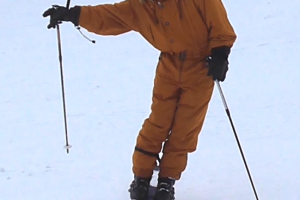
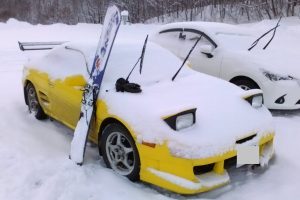


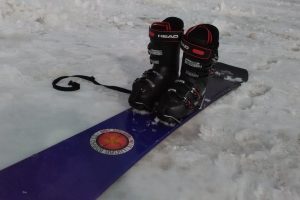

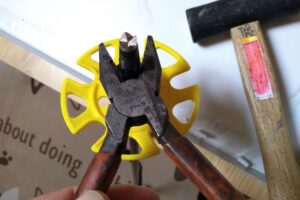
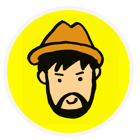
コメントを残す